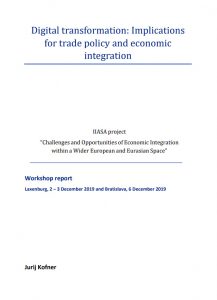 _ Yuri Kofner, research assistant, International Institute for Applied Systems Analysis (IIASA), junior, economist, MIWI – Instutute for Market Integration and Economic Policy. Laxenburg, 2020.
_ Yuri Kofner, research assistant, International Institute for Applied Systems Analysis (IIASA), junior, economist, MIWI – Instutute for Market Integration and Economic Policy. Laxenburg, 2020.
Kofner Y. (2020). Digital transformation: implications for trade policy and economic integration. IIASA Workshop Report. IIASA, Laxenburg.
DOWNLOAD
This research paper provides a summary of the deliberations of two expert seminars, organized by IIASA in 2019, supported by a review of the most up-to-date literature, on the impact of digitization on trade policy and economic integration. The report includes input from renowned researchers and policymakers from the OECD, WTO, UNCITRAL, DIGITALEUROPE, OeNB, European Commission and the Eurasian Economic Commission. Chapter one gives stylized facts on the trends in digitally-enabled trade. Chapter two discusses the issues with defining and measuring cross-border digital trade. Chapter three: examines tariff and non-tariff barriers specific to digital trade; discusses the features and effects of smart contracts, blockchain, and cryptocurrencies on international trade; deals with the rise of digital ecosystems, big data, the Internet of Things (IoT), and, especially, platform economies; in particular, issues of de minimis trade and taxing the digital economy; focuses on the implications of the digital transformation on regional trade agreements; and concludes with a discussion about free trade vs. protectionism in the digital economy. The main conclusions and policy recommendations are presented in the executive summary at the beginning of the paper.
IIASA continued a series of thematic workshops in the framework of the research project “Challenges and Opportunities of Economic Integration within a Wider European and Eurasian Space”, which aims to discuss, analyze, and critically evaluate diverse issues related to economic cooperation between countries and blocks within the Eurasian continent, covering the European Union, the Eurasian Economic Union, the Eastern Partnership, Central Asia, and their neighbors.
On 2-3 December 2019, IIASA organized a workshop on “Connectivity in the Digital Age. Digital Futures of Trade and Economic Cooperation in Eurasia”, which brought together participants from WTO, OECD, UNCITRAL, DIGITALEUROPE, OeNB, and other organizations to discuss the effects of the digital transformation on international trade, as well as on regional and trans-regional integration initiatives.
Specifically, this meeting aimed, inter alia, to overview available estimates of the effects of digital technologies on cross-border trade; to overview the digitalization dimensions of various trade agreements (e.g., USMCA, CPTPP, EU AAs), and to consider their applicability for the countries and blocs of the Eurasian region; to discuss the regulation of the digital economy in international legal instruments; to consider various aspects of the governance of digital technologies in the cross-border trade (especially in the aspect of big data governance); to review examples of successful digital cooperation in the region; to evaluate broad impacts of digitalization on trade administration (especially de minimis trade and taxation issues), and to develop recommendations for deepening digital cooperation in the region.
Related to that, on 6 December 2019, IIASA organized a side event at the 26th OSCE Ministerial Council in Bratislava, Slovak Republic on “Futures of international economic cooperation in Eurasia in the times of digital transformations” with the participation of high-level representatives from the OSCE, OECD, European Commission and the Eurasian Economic Commission to discuss, among other things, how fair competition can be promoted in the digital economy; how new technologies (e.g., artificial intelligence) will change business models; and how governments can stimulate digital transformation processes in the interests of citizens.
This IIASA report provides a summary of the deliberations from these two events, supported by a review of the most up-to-date literature.
